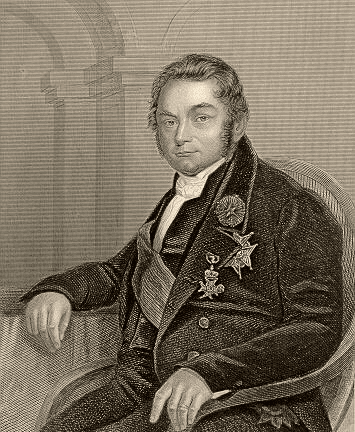 |
| Jons Jakob Berzelius. Engraving by Charles W. Sharpe and published by William Mackenzie, 1860. After Johan Olaf Sodermark. Smithsonian Libraries Image Gallery via Wikimedia. Public domain. |
Born in 1779 in East Gotland in the southern part of Sweden, Jons Jacob Berzelius descended from an old Swedish family in which many of his ancestors had been clergymen. His father, a schoolteacher, died when he was four years old. His mother soon remarried but died shortly thereafter in 1787, so he was raised with the five children of his mother’s second husband. There was only a half-hearted effort to care for him, and the arrangement was not conflict-free in that he was ill-treated by his cousins. At age fourteen he escaped by being admitted to a boarding school. For many years, in school and later at university, he had to support himself by working in various jobs: tutoring, glassblowing, or at a farm where he developed an interest in collecting and classifying flowers and insects rather than becoming a clergyman. Later, as an apprentice in a pharmacy, he learned the rudiments of chemistry.
In 1796 he enrolled in medical school at Uppsala, and at times had to interrupt his studies in order to support himself. Graduating in 1802, he settled down in Stockholm as a marginally paid physician to the poor. He also worked in the mineral springs to conduct an analysis of the water from this source and later was given a laboratory by the chemist owner of a mine who recognized his ability. Already in medical school he had become fascinated by Alessandro Volta’s chemical pile. He went on to construct a massive one, with 60 zinc plates and 60 copper plates, the principle of this arrangement being that when these plates are separated by a cloth soaked in brine, electrons from the copper would migrate to the zinc and generate an electrochemical current. This would allow the ions of an inorganic molecule to separate and migrate to what became known as the anode and cathode. Accordingly Berzelius became one of the first to adopt Dalton’s theory that inorganic molecules were composed of positively and negatively charged atoms. By applying this technique and principle later, Berzelius was able over time to isolate the new elements thorium, cerium, silicon, selenium, lithium, lanthanum, and vanadium. He determined their atomic weights and simplified Dalton’s original notation system so that O was written for oxygen, H for hydrogen, C for carbon, etc., this resulting in an improved periodic table of the elements. He was the first to make a distinction between organic and inorganic chemistry; coined the terms protein, polymer and isomer; developed modern analytical techniques in chemistry; and constructed what in effect was the first electrical battery.
In 1807, Berzelius became professor of chemistry and pharmacy at the Medical College in Stockholm, which soon thereafter became the Karolinska Institute and nowadays awards the Nobel Prize in Medicine. He lived at a difficult time for Sweden, which in 1808 was attacked by Russia, Denmark, and France, and by its ceding Finland to Russia, lost much of its Nordic empire. In 1809, Berzelius was elected to membership of the Royal Swedish Academy of Sciences and later became its secretary. In 1817, he declined an offer to become professor of medicine in Berlin. Remaining in Sweden all his life, he wrote over 200 papers and became a member of 94 learned societies. He married late in life, in 1835. In that same year, he was made a baron by the Swedish king Charles XIV. His 1808 chemistry book remained a standard reference textbook for many years. He traveled extensively and was honored wherever he went. Most of his life he suffered from recurrent migraines, gout, and episodes of depression, and in 1818, he had a nervous breakdown, supposedly due to the stress of his work. He died in 1848. Along with Robert Boyle, John Dalton, Antoine Lavoisier, and Humphry Davy, Berzelius is considered to be one of the founders of modern chemistry. A museum, a street, a public park, and a mineral were named after him. He was featured by having a stamp issued by his country and a statue erected in his honor in Stockholm, and students working in modern chemistry laboratories are reminded of the achievements of this great man whenever they use a Berzelius flask.
GEORGE DUNEA, MD, Editor-in-Chief

Leave a Reply